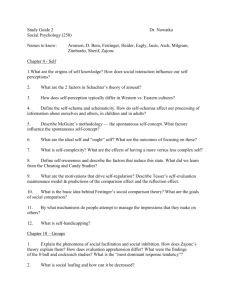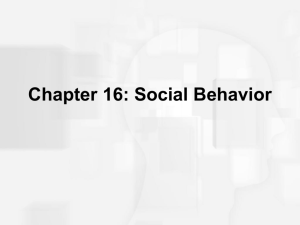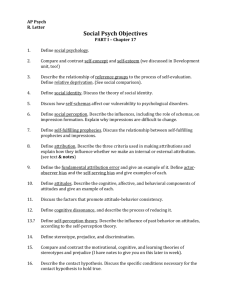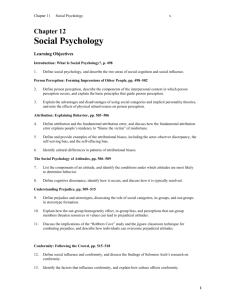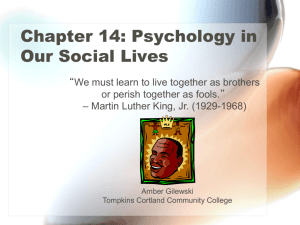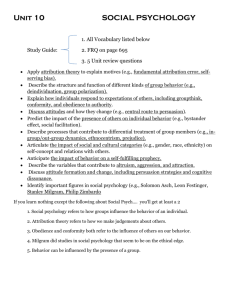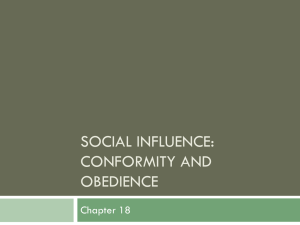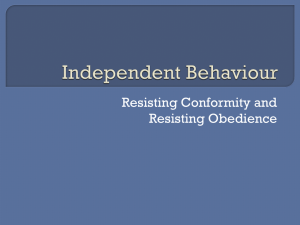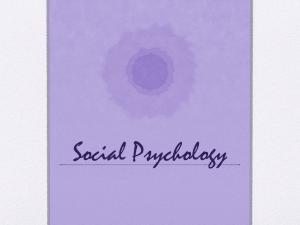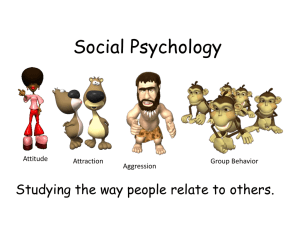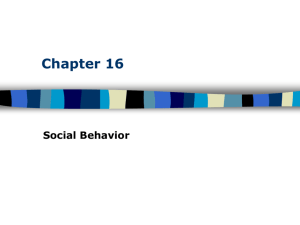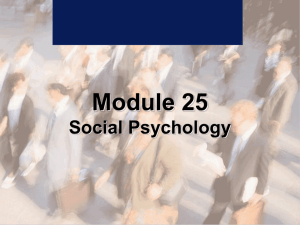Study guide for Exam 2
advertisement
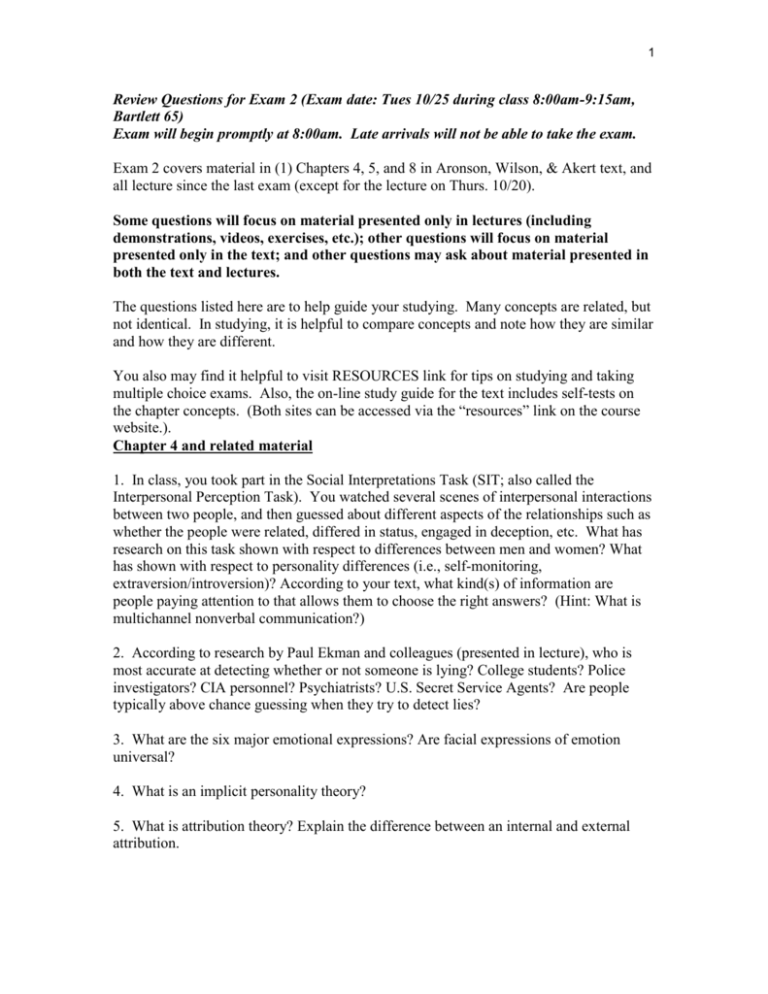
1 Review Questions for Exam 2 (Exam date: Tues 10/25 during class 8:00am-9:15am, Bartlett 65) Exam will begin promptly at 8:00am. Late arrivals will not be able to take the exam. Exam 2 covers material in (1) Chapters 4, 5, and 8 in Aronson, Wilson, & Akert text, and all lecture since the last exam (except for the lecture on Thurs. 10/20). Some questions will focus on material presented only in lectures (including demonstrations, videos, exercises, etc.); other questions will focus on material presented only in the text; and other questions may ask about material presented in both the text and lectures. The questions listed here are to help guide your studying. Many concepts are related, but not identical. In studying, it is helpful to compare concepts and note how they are similar and how they are different. You also may find it helpful to visit RESOURCES link for tips on studying and taking multiple choice exams. Also, the on-line study guide for the text includes self-tests on the chapter concepts. (Both sites can be accessed via the “resources” link on the course website.). Chapter 4 and related material 1. In class, you took part in the Social Interpretations Task (SIT; also called the Interpersonal Perception Task). You watched several scenes of interpersonal interactions between two people, and then guessed about different aspects of the relationships such as whether the people were related, differed in status, engaged in deception, etc. What has research on this task shown with respect to differences between men and women? What has shown with respect to personality differences (i.e., self-monitoring, extraversion/introversion)? According to your text, what kind(s) of information are people paying attention to that allows them to choose the right answers? (Hint: What is multichannel nonverbal communication?) 2. According to research by Paul Ekman and colleagues (presented in lecture), who is most accurate at detecting whether or not someone is lying? College students? Police investigators? CIA personnel? Psychiatrists? U.S. Secret Service Agents? Are people typically above chance guessing when they try to detect lies? 3. What are the six major emotional expressions? Are facial expressions of emotion universal? 4. What is an implicit personality theory? 5. What is attribution theory? Explain the difference between an internal and external attribution. 2 6. What are the assumptions of Kelley’s Covariation Model? Specifically, does Kelley see people as rational, logical processors of information, or illogical, error-prone processors? 7. What is the fundamental attribution error? Explain how it relates to the findings of Jones and Harris' study in which students listened to or read Pro- or Anti-Castro essays. 8. Explain Dan Gilbert's theory about the two steps involved in making attributions. 9. In lecture, we discussed the questioner/contestant study in which students participated in a simulated quiz show. What were the findings of this study? Be sure to know the results for questioners, contestants, and observers. 10. How is perceptual salience related to the fundamental attribution error? Explain the results of the study by Taylor and Fiske (1975, text p. 114). 11. What is a self-serving attribution? How does it relate to internal versus and external attributions for success and failure? 12. What is the actor-observer effect? What is the role of perceptual salience? What is the role of the level of information available? 13. To what extent does the fundamental attribution error occur in Western cultures? In Eastern cultures? (What differences exist between collectivist vs. individualistic cultures in their attention to dispositional versus situational factors?) 14. What is the spotlight effect? Why does it occur? 15. What is true about the accuracy of people's attributions and impressions? In particular, how accurate are people in their judgments of people they have just met? Of close friends? What is the role of mental shortcuts? 16. Define unrealistic optimism, the belief in a just world, and defensive attributions. In what way is unrealistic optimism a defensive attribution? In what way is the belief in a just world a defensive attribution? Chapter 5 & associated lecture material 1. Define and note the differences between the following terms: self-concept, selfawareness, self-schemas, working self-concept (lecture), universe of self-conceptions (lecture). 2. What cross-cultural differences have been noted in views of the self? In particular, what differences exist between Western (e.g., U.S.) and Eastern (e.g., Japan, China, India) cultures? 3 3. What is introspection? How much time do people spend thinking about themselves relative to doing other things? And, when people introspect, are they always consciously aware of the true causes of their feelings and behavior? 4. What is a self-schema? What is a spontaneous self-concept? Know the difference between these two concepts. 5. What are the main ideas of self-awareness theory? What are the typical consequences of self-focus for (a) the person’s mood, and (b) the person’s behavior? In the Halloween trick-or-treat study (lecture), kids were asked to take only one piece of candy, but they did this either in front of a full length mirror or no mirror. Explain the relevance of this study to self-awareness theory and describe the findings of the study. 6. What is the general finding of McGuire’s research on the spontaneous self-concept (e.g., as measured using the “WhoAm I” test you completed in class)? 7. In class, we discussed several mechanisms of self-enhancement: basking in reflected glory, downward social comparison, self-handicapping, and defensive pessimism. Define each of these concepts and be able to distinguish among them. (It may be helpful to think of a real life example for each concept.) 8. In a video shown in class, you watched students at the University of Georgia take a word test and perform very poorly (i.e., Abraham Tesser’s research). They then provided clues for a similar test to either a friend or stranger. Describe the results of the study and how they are related to preserving a positive self-view. 9. According to lecture, why does the study of the self fall within the domain of social psychology? (Hint: Think about how the self-concept develops, and about the role of the situation.) Is the self a single, monolithic entity, or is it multifaceted? 10. What is self-esteem (as defined in lecture)? Know the difference between selfesteem and other “self” terms (e.g., self-schema, self-awareness, etc.). 11. What is the overjustification effect? How is it different from the definitions of intrinsic motivation and extrinsic motivation? How are task-contingent rewards versus performance-contingent rewards related to intrinsic motivation? Under what conditions will extrinsic rewards decrease intrinsic motivation? 12. What is the main idea of Bem’s (know this name) self-perception theory? 13. Stanley Schachter’s (know this name) two-factor theory of emotion is described in your test. What are the two steps involved in this theory? What is the role of the situation in this theory? 14. Define and be able to distinguish among: self-discrepancy theory; self-perception theory; self-verification theory; self-affirmation theory 15. What is the self-reference effect? 16. Under what conditions will praising children for their performance produce negative effects? Positive effects? 17. What did work by Shelley Taylor and colleagues find in examining cancer patients’ assessments of their futures? 18. Be able to distinguish among: the looking glass self; social comparison theory; selfverification theory. 19. What are the organizational and self-regulation (executive) functions of the self? What is the self-regulatory resource model, and the results of research related to it? Chapter 8 (Conformity) and associated material 4 1. What is conformity? Obedience? How are they similar and different from each other? 2. What did Sherif’s classic research on the autokinetic effect (know this term) in which people had to estimate how far a point of light appeared to move in a dark room demonstrate about conformity? Explain how the notion of informational social influence is important for understanding these findings. 3. When will people conform to informational social influence? That is, what situations are most likely to lead to conformity because of informational social influence? 4. What is the relationship between normative social influence and public compliance? Private acceptance? 5. What is the relationship between informational social influence and public compliance? Private acceptance? 6. In Solomon Asch’s (know this name) classic line judgment experiments, what did he find? Why did people conform in this situation? What happened when Asch changed the study so that the participants wrote their answers on pieces of paper? What happened when 6 confederates gave the wrong answer, but the 7th gave the correct answer on every trial? 7. What are the findings of cross-cultural studies using the Asch paradigm? For example, are the Japanese as likely to conform as North Americans? What about Germans, French, and Norwegians? 8. Compare and contrast informational social influence and normative social influence. 9. What are the main ideas of Latane’s social impact theory? 10. Based on the results of a meta-analysis by Eagly and Carli (1981), reported in your text, what can we conclude about gender differences in conformity? (Are they big or small? Are women or men more easily influenced?) 11. What were the findings of Stanley Milgram’s (know this name) original study of obedience? In the video version of the study, approximately what percent of participants continued all the way to the end of the shock panel? How were the findings changed when (a) the experimenter gave commands from a different room? (b) the teacher had to physically place the learner’s hand on the shock plate? (c) the study was conducted in the city of Bridgeport in a run-down office building, (d) the teacher does not deliver the shock, but helped out? (e) the teacher is told to choose the level of shock to give to the learner? (For Milgram’s studies, know approximately the percentage of people who obeyed in each variation of the paradigm. Which type of study showed the highest rates of obedience? Which showed the lowest rates of obedience?) 12. Milgram asked students, middle class adults, and psychiatrists to predict how far people would go in the teacher-learner shock paradigm. What did he find? (Know the approximate percentages estimated.) 13. According to your text, what roles might the following variables have played in producing obedience in Milgram’s research?: informational social influence, normative social influence, gradual commitment (foot-in-the-door), and dissonance reduction. 14. What has research (Blass, 1999) found about the association between the rate of obedience in Milgram-like studies and the time period in which the study was conducted (e.g., from earlier time periods in the 1960’s to later time periods in the 1980’s)? 5 15. In class, we discussed conceptual replications of Milgram’s studies – one in which an unknown doctor called up nurses and asked them to administer a drug, “Astroten,” to patients. Another study had participants give shocks to a cute puppy. What were the findings of these studies? 16. Describe the findings of Schachter’s “Johnny Rocco” study in which a confederate, Bibb, voiced opinions that were at odds with those of the rest of the group. 17. Why does the chapter on conformity discuss social influence and women’s body image? 18. What did Judith Anderson et al. (1992) find when they assessed what people in 54 cultures considered to be the ideal female body? 19. Chris Crandall (1988) investigated binging and purging among sorority members. What did his research demonstrate? 20. Define idiosyncrasy credits and explain how they are relevant to group processes. 21. Compare and contrast descriptive versus injunctive norms. What did the study by Reno et al., 1993 show with respect to these norms, and which norm seems to more powerfully influence behavior? 22. What is mass psychogenic illness? Why would it be discussed in a chapter on social influence?
